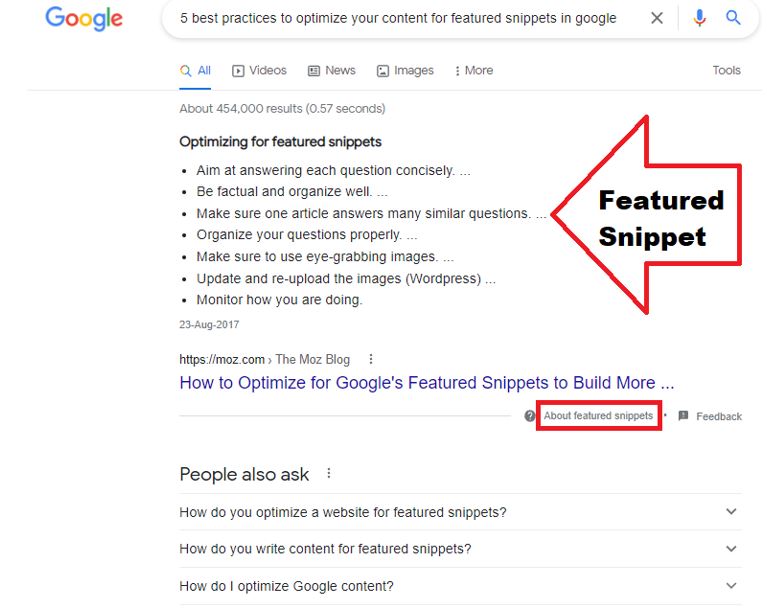
Google consistently updates its features for listing search results. That is why you can’t rely solely on what you already know. You need to keep abreast of these changes if only to ensure that your content marketing efforts remain timely and competitive. Case in point: Google featured snippets.
Search Engine Land reports that being featured in a Google snippet can improve click-through rate (CTR) from 2% to 8%. Meanwhile, the feature’s yielded increase in sessions can reach up to 516%. Broken down to the type of gadget used, session boost from organic traffic are as follows:
- Desktop – 578%
- Mobile – 505%
- Tablet – 399%
From these, we can safely conclude that it’s imperative to optimize content so that Google will take notice enough to devote a snippet to it. Doing so can do wonders for your conversion rate. Moreover, it will elevate your content marketing services.
What is Google featured snippet?
Also called position zero, think of a Google featured snippet as an isolated search result. Google recognizes the credibility of a specific content enough for it to deserve a box above the rest of the listed results triggered by a query.
Unlike the traditional organic results, a Google snippet features an extract from existing content above the URL. That gives the searcher a quick overview of what’s in store for them should they decide to click on the content.
Google snippets have been around for a while. Before, appearing on a Google snippet means your content is featured twice on the result’s first page. This changed when Google decided to tweak how snippets worked in January 2020. A snippet meant you no longer appear in the traditional Google search results.
Come June 2020, Google made another round of updates. When a searcher clicks on a snippet, they are taken straight to the relevant text highlighted in yellow.
Even with these updates, digital marketers still consider Google snippets as a holy grail of content optimization. That’s owing to the snippet’s prominent place on the first page of a search query. Even without the additional appearance in the traditional listing, it no doubt commands attention and interest.
What are the types of featured snippets?
Featured snippets may be confused with other results snippets powered by Google. For instance, there are Rich Answers or Quick Answers. These are facts deemed part of the public domain, such as the size of the planet Earth. In this case, Google does not credit the source.
There’s also the Knowledge Graph, typically featured as a gallery of photos. Meanwhile, the Rich Snippet comes alongside ratings, pricing information, and product availability.
The three types of Google featured snippets are as follows.
- Paragraph – This is the snippet people are most familiar with. The goal of this is to answer the query of the searcher question as concisely as possible. Additional information is included to spark the reader’s interest.
- List – A numbered or bulleted snippet usually appears when the searcher types in a how-to question. For example, if you look up a chocolate cookie recipe, Google will offer the most relevant answer via a straightforward list, such as a step-by-step instruction.
- Table – These make up 29% of all featured snippets. They are often seen when you need statistics and other table-ready data.
How to Optimize Your Content for Featured Google Snippets?
Ahrefs reports that 99.58% of content used as featured snippets are already in the top 10 of Google’s SERPs. That should be enough to convince you to attain a spot in that exclusive box. To pull that off, here’s what you can do.
1. Know if your competitors are on the snippets
One of the reliable analytics tools for digital marketers is SEMrush. This will allow you to look into not only the snippets which you’re already ranking well for but also the ones your competitors have earned. You can use the knowledge you glean from SEMrush to optimize whatever content you want to become a featured snippet based on what worked for your competitors.
2. Keyword research
Keyword research is the core of search engine optimization. If you’re gunning for a featured snippet appearance, you need to go back to basics. Studies confirm that a huge chunk of featured snippets results from long-tail keywords. So, find the best long-tail keywords you can incorporate in your content for a specific Google query.
3. Brainstorm questions
Search keywords formatted as questions usually trigger featured snippets. Naturally, you can zero in on questions that the public tends to ask. You may refer to Answer the Public for insights and utilize the 5Ws and 1H of asking questions.
4. Identify your high-ranking content
Get started with high-ranking content at your disposal. Use the Google Search Console to know where the bulk of your clicks comes from. Optimize those keywords and phrases.
5. Answer multiple questions in one content
Content that has been a Google snippet for one query has a better shot of appearing as a snippet again for a different search query. Optimize your content in a way that not only uses the keywords but offers a plethora of helpful information, too.
Get an exclusive feature
Content optimization is an ever-evolving game, and it’s in your best interest to keep up. Know what Google’s newest features are and tailor your digital marketing efforts accordingly.
Right now, Google snippets will work in your favor if done right. Master the ins and outs of this feature and follow the strategies mentioned here. Make sure to properly and consistently measure results to finetune the content marketing services you offer further.
Was this helpful?
1 / 0